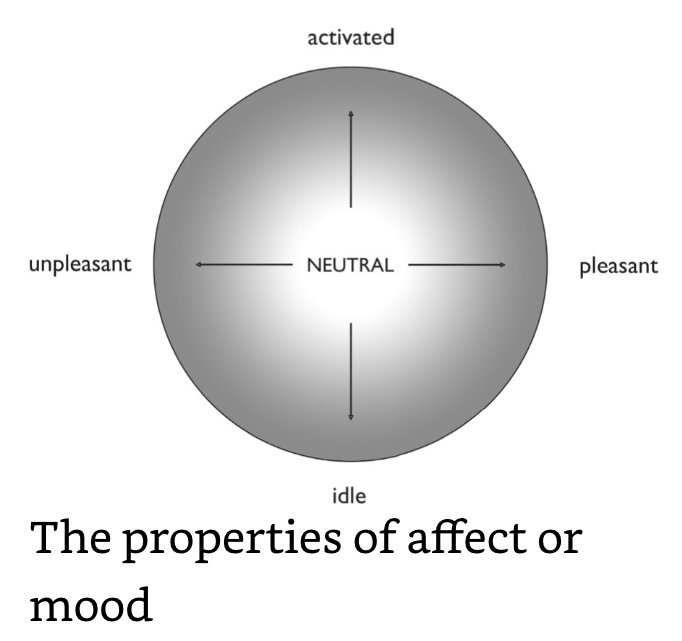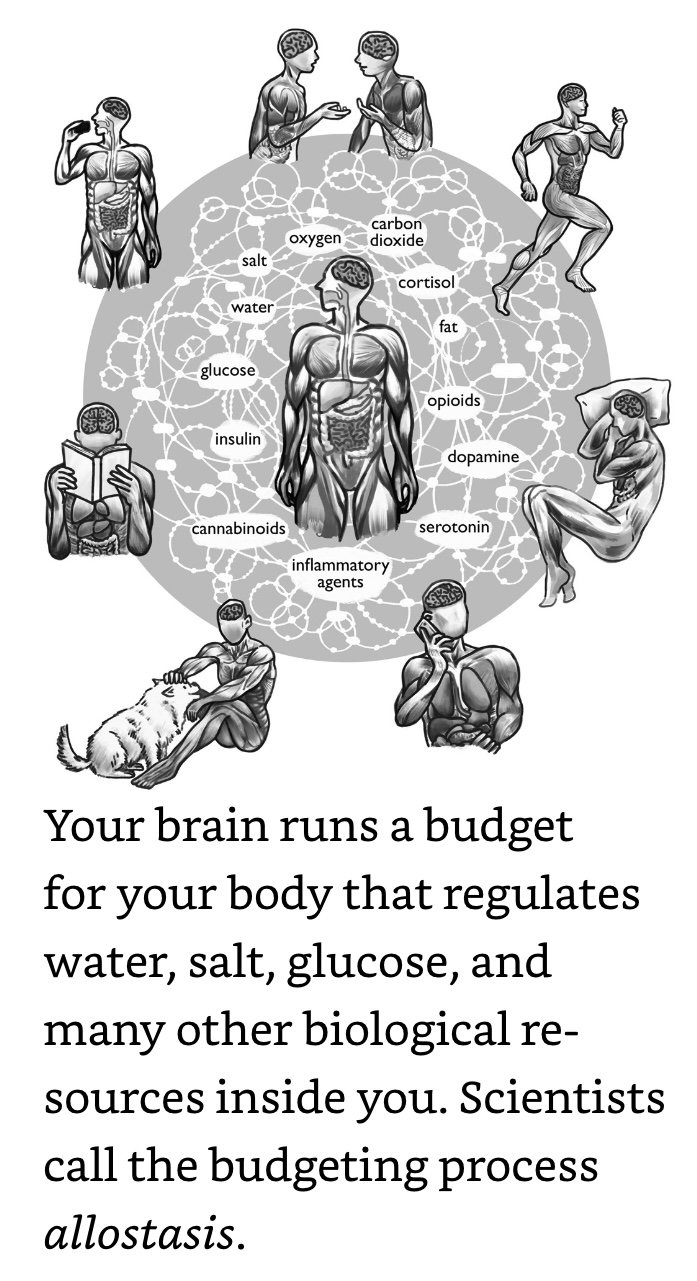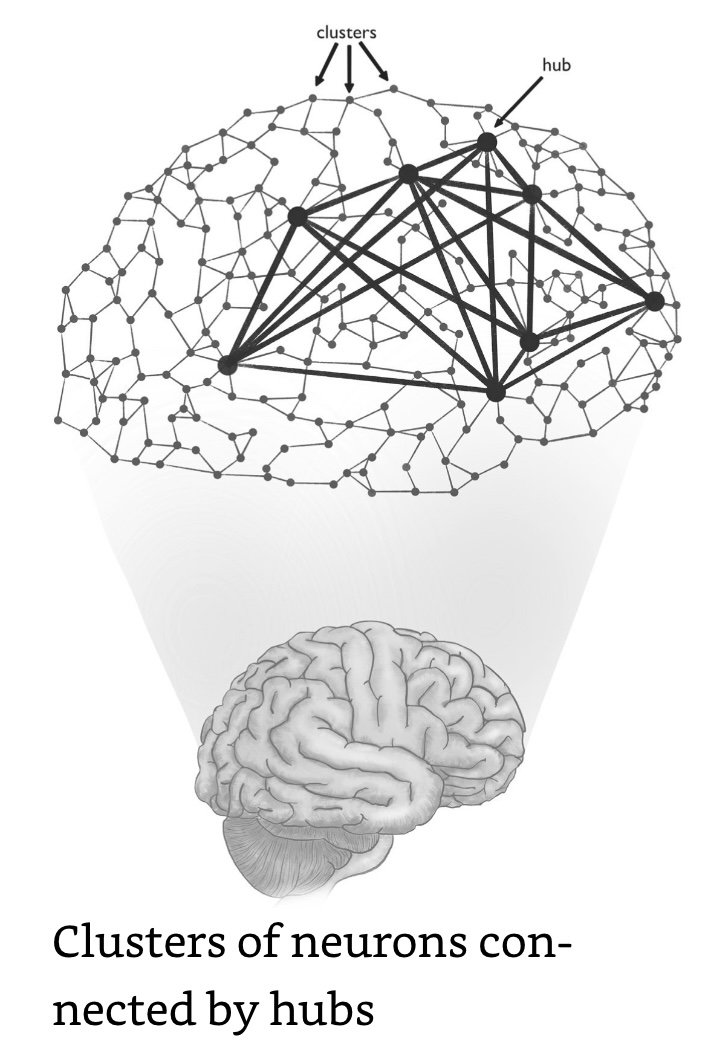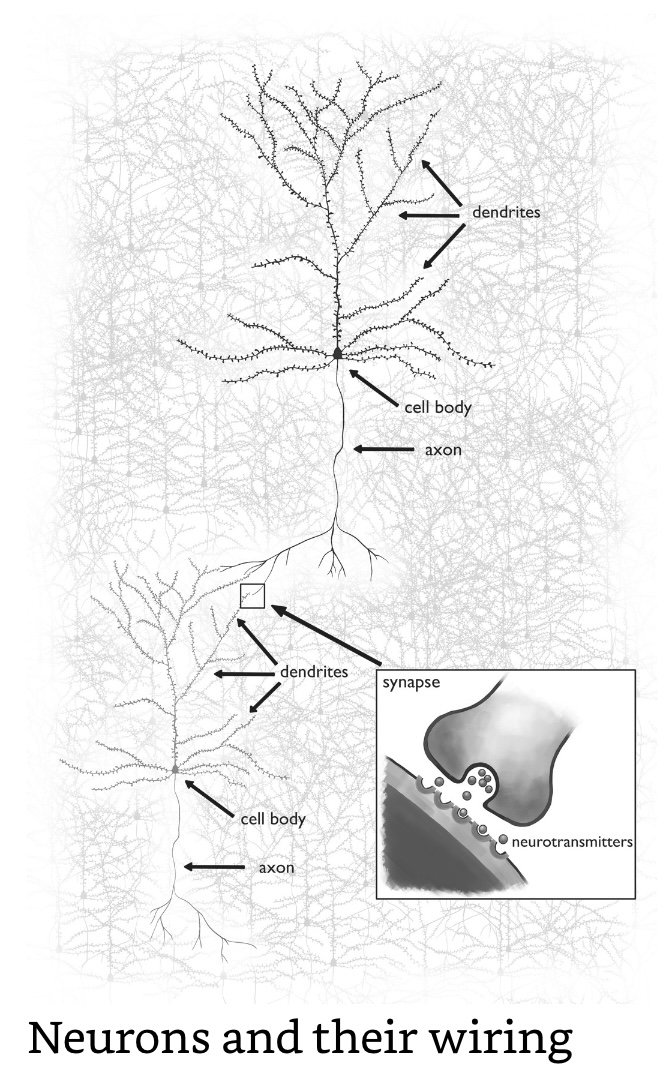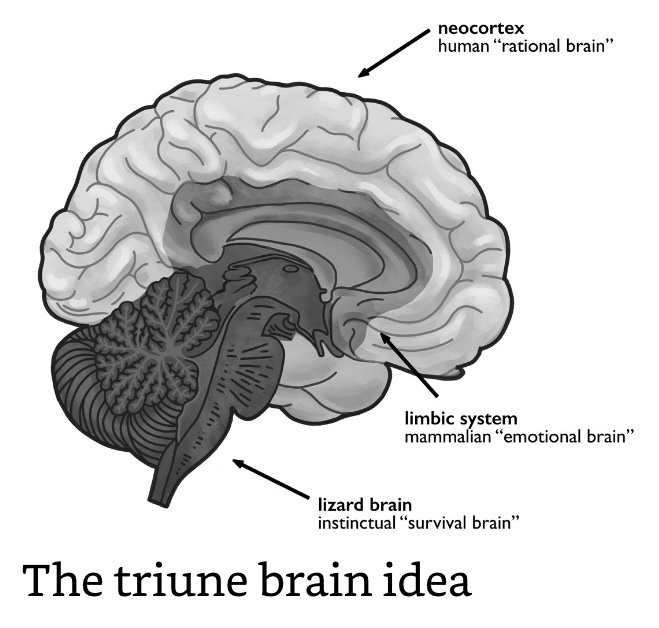7 ½ Lessons About the Brain by Barrett
Ref: Lisa Barrett (2020). 7 ½ Lessons About the Brain. Pan Macmillan, UK.
___________________________________________________________________________
Summary
ONCE UPON A TIME, you were a little stomach on a stick, floating in the sea. Little by little, you evolved. You grew sensory systems and learned that you were part of a bigger world. You grew bodily systems to navigate that world efficiently. And you grew a brain that ran a budget for your body. You learned to live in groups with all the other little brains-in-bodies. You crawled out of the water and onto land. And across the expanse of evolutionary time—with the innovation that comes from trial and error and the deaths of trillions of animals—you ended up with a human brain.
Your brain’s most important job is to control your body—to manage allostasis—by predicting energy needs before they arise so you can efficiently make worthwhile movements and survive.
Allostasis: Body budgeting; automatically predicting and preparing to meet the body’s needs before they arise.
Each of us can be the kind of person who makes more deposits into other people’s body budgets than withdrawals or the kind of person who is a drain on the health and welfare of those around us.
You don’t have an inner lizard or an emotional beast-brain. There is no such thing as a limbic system dedicated to emotions. And your misnamed neocortex is not a new part; many other vertebrates grow the same neurons that, in some animals, organize into a cerebral cortex if key stages run for long enough. Anything you read or hear that proclaims the human neocortex, cerebral cortex, or prefrontal cortex to be the root of rationality, or says that the frontal lobe regulates so-called emotional brain areas to keep irrational behavior in check, is simply outdated or woefully incomplete.
___________________________________________________________________________
The Half-Lesson Your Brain Is Not for Thinking
Hunting didn’t require a brain, but it was a big step toward developing one. The emergence of predators during the Cambrian transformed the planet into a more competitive and dangerous place. Both predators and prey evolved to sense more of the world around them. They began to develop more sophisticated sensory systems…When it came to body budgeting, prediction beat reaction. A creature that prepared its movement before the predator struck was more likely to be around tomorrow than a creature that awaited a predator’s pounce.
Newer animals developed intricate internal systems, like a cardiovascular system with a heart that pumps blood, a respiratory system that takes in O and eliminates CO2, and an adaptable immune system that fights infection. Systems like these made body budgeting much more challenging…As animals gradually evolved bigger bodies with more systems to maintain, their handful of body-budgeting cells also evolved to become brains of greater and greater complexity.
Evolution does not act with purpose.
___________________________________________________________________________
Lesson 1 You Have One Brain (Not Three)
Triune Brain Idea: One of the most successful and widespread errors in all of science.
“Your human mind is a never-ending battle between three inner forces to control your behavior. One force consists of basic survival instincts, like hunger and sex drive. The second force consists of your emotions, such as joy, anger, and fear. Together, your instincts and emotions are like animals that can pull your behavior in divergent, perhaps ill-advised directions. To counteract this chaos, you have the third inner force, rational thought, to rein in both beasts and guide you on a more civilized and righteous path.”-Plato.
Once upon a time, they said, we were lizards. 300 Ma, that reptilian brain was wired for basic urges like feeding, fighting, and mating. ~100M years later, the brain evolved a new part that gave us emotions; then we were mammals. Finally, the brain evolved a rational part to regulate our inner beasts. We became human and lived logically ever after. According to this evolutionary story, the human brain ended up with three layers—one for surviving, one for feeling, and one for thinking— the triune brain. The deepest layer, or lizard brain, which we allegedly inherited from ancient reptiles, is said to house our survival instincts. The middle layer, dubbed the limbic system, supposedly contains ancient parts for emotion that we inherited from prehistoric mammals. The outermost layer, part of the cerebral cortex, is said to be uniquely human and the source of rational thought; it’s known as the neocortex (“new cortex”). One part of your neocortex, called the prefrontal cortex, supposedly regulates your emotional brain and your lizard brain to keep your irrational, animalistic self in check.
The three-layered brain was proposed by several scientists over the years and formalized in the mid-20c by a physician named Paul MacLean.
In the 1930s, neuroanatomist James Papez proposed a “cortical circuit” dedicated to emotion. His circuit went beyond the thalamus and hypothalamus to include cortical regions that border the subcortical regions (the cingulate cortex) and were therefore assumed to be ancient. This segment of cortex was dubbed the limbic lobe by the neurologist Paul Broca 50y earlier (limbic- border in Latin). This tissue abuts the brain’s sensory systems and the motor system that moves your arms, legs, and other body parts. Broca thought the limbic lobe housed primitive survival faculties, like the sense of smell.) In the late 1940s, the neuroscientist Paul MacLean transformed Papez’s “cortical circuit” into a full-fledged limbic system and embedded it within a three-layered brain that he named the triune brain.
Even though the limbic system is a myth, your brain does contain something called limbic circuitry. Neurons in limbic circuitry connect to the brain stem nuclei that regulate your autonomic nervous system, immune system, endocrine system, and other systems whose sense data create interoception, your brain’s representation of the sensations in your body. Limbic circuitry is not exclusive to emotion and is distributed across multiple brain systems. It includes subcortical structures, such as the hypothalamus and the central nucleus of the amygdala; allocortical structures, such as the hippocampus and the olfactory bulb; and parts of the cerebral cortex, such as the cingulate cortex and the anterior part of the insula.
Primary Somatosensory Cortex: Collectively, your brain has four clusters of neurons, or brain regions, that allow you to sense your body movements and help create your sense of touch.
The size of our cerebral cortex is not evolutionarily novel and does not require any special explanation.
Cerebral Cortex: A sheet of neurons arranged in layers that covers the subcortical (‘below the cortex’) parts of your brain.
During the course of evolution, certain genes mutated to cause particular stages of brain development to run for longer or shorter times, producing a brain with proportionally bigger or smaller parts.
Perhaps rationality is better defined in terms of the brain’s most important job: body budgeting—managing all the water, salt, glucose, and other bodily resources we use every day. In this view, rationality means spending or saving resources to succeed in your immediate environment.
What we call mental illnesses may be rational body-budgeting for the short term that’s out of sync with the immediate environment, the needs of other people, or your own best interests down the road.
My view is that some of the distinctive capacities of a human brain come from a combination of a big cerebral cortex (not bigger than expected for the overall brain size, mind you, just big in absolute terms) and souped-up connections between neurons in certain parts of the cortex, including upper layers of the prefrontal cortex. Some scientists, myself included, hypothesize that these features give humans the ability to understand things by their function rather than their physical form,
___________________________________________________________________________
Lesson 2 Your Brain Is a Network
Aristotle believed the brain was a cooling chamber for the heart.
Phrenology: Portrays the brain as a jigsaw puzzle, where each piece produces a different human quality, such as self-esteem, destructiveness, or love.
Some scientists describe the human mind as a collection of “mental organs” for fear, empathy, jealousy, and other psychological tools that evolved for survival, but the brain itself isn’t structured like that. Your brain also does not “light up” with activity, as if some parts are on and others off. It does not “store” memories like computer files to be retrieved and opened later. These ideas are metaphors that emerged from beliefs about the brain that are now outdated.
Psychologist Daniel Kahneman is very clear that Systems 1 and 2 are metaphors about the mind; but they are often mistaken for brain structures.
A metaphor’s simplicity, however, can become its greatest failing if people treat the metaphor as an explanation.
The Brain
Your brain is a network of ~128B neurons connected as a single, massive, and flexible structure.
Your 128B neurons continually fire off communications to each other, day and night. When a neuron fires, an electrical signal races down its trunk to its roots. This signal causes the roots to release chemicals into the gaps between neurons, called synapses. The chemicals travel across synapses and attach to another neuron’s bushy top, causing that neuron to fire as well, and voilà, one neuron has passed information to another. This arrangement of dendrites, axons, and synapses knits your 128B individual neurons into a network.
Each neuron directly passes information to just a few thousand other neurons and receives information from a few thousand others, give or take, yielding > 500T neuron-to-neuron connections.
Overall, no neuron has a single psychological function, though a neuron may be more likely to contribute to some functions than others.
Generally speaking, each neuron looks like a little tree, with bushy branches at the top, a long trunk, and roots at the bottom. The bushy branches, which are called dendrites, receive signals from other neurons, and the trunk, which is called the axon, sends signals to other neurons through its roots.
Typically, the axon terminals of one neuron are close to the dendrites of thousands of other neurons, but they do not touch, and the intervening spaces are called synapses. When a neuron’s dendrites detect the presence of chemicals, the neuron “fires” by sending an electrical signal down its axon to its axon terminals, which release their neurotransmitters into the synapses; the neurotransmitters then attach to receptors on the other neurons’ dendrites. (Other cells, called glial cells, help the process along and prevent chemical leaks.) This is how neurochemicals excite or inhibit the receiving neurons and change their rate of firing.
Hub: Areas of the brain with large volumes of neurons that complete complex tasks.
Hub damage is associated with depression, schizophrenia, dyslexia, chronic pain, dementia, Parkinson’s disease, and other disorders. Hubs are points of vulnerability because they are points of efficiency—they make it possible to run a human brain in a human body without depleting a body budget.
Neurotransmitters: Chemicals that complete the local connections between neurons; include glutamate, serotonin, and dopamine. Our brain wiring is bathed in these chemicals.
Neuromodulator: Brain chemicals, such as serotonin and dopamine, that can act on neurotransmitters to dial up or dial down their effects.
Plasticity: Neurons die, and in some parts of the human brain, neurons are born. Connections become more or less numerous, and they become stronger when neurons fire together and weaker when they don’t.
Degeneracy: The ability of neurons (and even bodily systems) to conduct functions it normally doesn’ty conduct.
The brain’s dynamic behavior—slow changes by plasticity, faster changes by neurotransmitters and neuromodulators, and the flexibility of neurons with multiple jobs.
Complexity: The brain’s ability to configure itself into an enormous number of distinct neural patterns.
Remembering: A brain doesn’t store memories like files in a computer—it reconstructs them on demand with electricity and swirling chemicals. We call this process remembering but it’s really assembling.
Brains of higher complexity are also more creative. A complex brain can combine past experiences in new ways to deal with things that it has never encountered before.
___________________________________________________________________________
Lesson 3 Little Brains Wire Themselves to Their World
To a remarkable extent, a baby’s genes are guided and regulated by the surrounding environment. The brain areas that are most centrally involved in vision, for example, develop normally after birth only if a baby’s retinas are regularly exposed to light. An infant’s brain also learns to locate sounds in the world based on the specific shape of the baby’s ear. To make matters even stranger, a baby’s body requires some additional genes that sneak in from the outside world. These tiny visitors travel inside of bacteria and other critters and affect the brain in ways that scientists are only beginning to understand.
As information travels from the world into the newborn brain, some neurons fire together more frequently than others, causing gradual brain changes that we’ve called plasticity. These changes nudge the infant’s brain toward higher complexity via two processes we’ll call tuning and pruning.
Tuning: Strengthening the connections between neurons. If we think again of neurons as little trees, tuning means that the branch-like dendrites become bushier. It also means that the trunk-like axon develops a thicker coating of myelin, a fatty “bark” that’s like the insulation around electrical wires, which makes signals travel faster.
Pruning: Less-used neuron connections weaken and die off.
In general, toddlers learn to tend their own body budgets better when their caregivers create learning opportunities for them instead of hovering and taking care of their every need.
Your brain network contains smaller communities of neurons whose main job is to focus on certain details as important and ignore other details as irrelevant. Your brain focuses its spotlight of attention continually and automatically, and often you’re unaware that it’s happening.
Childhood poverty costs society ~$1T/year, according to a 2019 report by the National Academies of Sciences, Engineering, and Medicine.
Chronic stress causes brain atrophy. It reduces brain tissue, notably in parts of the brain that are important for body budgeting (allostasis), learning, and cognitive flexibility.
Chronic verbal abuse in childhood predisposes people to mood disorders in young adulthood. However, an alternative interpretation is that people who suffer from mood disorders remember more abuse, including verbal abuse.
An increasing number of studies consistently reveal a link between sustained social stress, usually involving verbal aggression, and an increased incidence of psychiatric and physical disease. For example, there is evidence that verbal aggression can alter the immune response sufficiently to reactivate latent herpes viruses, reduce the benefits of common vaccines, and slow the healing of wounds. These are not studies of vulnerable people but of average people who were drawn from across the political spectrum. I should also point out that these findings hold whether or not test subjects report experiencing intense stress.
Research shows that early and long exposure to poverty is bad for the developing brain. Inadequate nutrition, interrupted sleep due to street noise, poor temperature regulation due to lack of heat or ventilation, and other circumstances of poverty may alter the development of the front of the cerebral cortex, namely the prefrontal cortex. This brain area is involved in a range of critical functions, including attention, language, and body budgeting…On average, adversity and poverty are afflictions from which little brains struggle to recover.
Cultural Inheritance: Each little brain becomes optimized for its particular environment, the one it developed in. Caregivers curate a baby’s physical and social niche, and the baby’s brain learns that niche. When the baby grows up, he perpetuates that niche by passing his culture to the next generation through his words and actions, wiring their brains in turn. This process is efficient and frugal because evolution doesn’t have to encode all our wiring instructions in genes. It off-loads much of the job to the world around us, including other humans in that world.
When it comes to the brain, simple distinctions like nature versus nurture are alluring but not realistic. We have the kind of nature that requires nurture.
Little brains wire themselves to their world. It’s up to us to create that world—including a social world rich with wiring instructions—to grow those brains healthy and whole.
___________________________________________________________________________
Lesson 4 Your Brain Predicts (Almost) Everything You Do
Data does not arrive in the form of the meaningful sights, smells, sounds, and other sensations that most of us experience. It’s just a barrage of light waves, chemicals, and changes in air pressure with no inherent significance.
Scientists are now fairly certain that your brain actually begins to sense the moment-to-moment changes in the world around you before those light waves, chemicals, and other sense data hit your brain. The same is true for moment-to-moment changes in your body—your brain begins to sense them before the relevant data arrives from your organs, hormones, and various bodily systems.
If your brain has predicted well, then your neurons are already firing in a pattern that matches the incoming sense data. That means this sense data itself has no further use beyond confirming your brain’s predictions. What you see, hear, smell, and taste in the world and feel in your body in that moment are completely constructed in your head. By prediction, your brain has efficiently prepared you to act.
Your brain is wired to initiate your actions before you’re aware of them.
Sense data is collected by various sense organs in your body, such as your eyes, ears, nose, and so on, and converted into neural signals that the brain can use.
___________________________________________________________________________
Lesson 5 Your Brain Secretly Works with Other Brains
Plasticity: Microscopic parts of your neurons change gradually every day through tuning and pruning.
When you have empathy for other people, your brain predicts what they’ll think and feel and do. The more familiar the other people are to you, the more efficiently your brain predicts their inner struggles.
It’s important to understand that the human brain doesn’t seem to distinguish between different sources of chronic stress. If your body budget is already depleted by the circumstances of life—like physical illness, financial hardship, hormone surges, or simply not sleeping or exercising enough—your brain becomes more vulnerable to stress of all kinds.
A long period of chronic stress can harm a human brain. Scientific studies are absolutely clear on this point.
One study found that if you’re exposed to social stress within 2h of a meal, your body metabolizes the food in a way that adds 104 Cal to the meal. If this happens daily, that’s 5kg gained per year! Not only that, but if you eat healthful, unsaturated fats, such as those found in nuts, within 1d of being stressed, your body metabolizes these foods as if they were filled with bad fats.
There’s an authentic tension between a belief in individual freedom, which implies you can say almost anything you want to anyone, and the biological fact that humans have socially dependent nervous systems, which means your words affect other people’s bodies and brains.
The price of personal freedom is personal responsibility for your impact on others.
Each of us can be the kind of person who makes more deposits into other people’s body budgets than withdrawals or the kind of person who is a drain on the health and welfare of those around us.
___________________________________________________________________________
Lesson 6 Brains Make More than One Kind of Mind
A particular human brain in a particular human body, raised and wired in a particular culture, will produce a particular kind of mind. There is not one human nature but many.
Brains have a lot of common features; minds, less so, because minds depend in part on micro-wiring that is tuned and pruned by culture.
Mood: The general sense of feeling that comes from your body.
Where does affect come from? In every moment—like right now, as you read these words—your hormones, organs, and immune system are producing a storm of sense data, and you’re barely aware of it. You notice your heartbeat and breathing only when they’re intense or you focus on them. You almost never notice your body temperature unless it’s too high or too low. Your brain, however, makes meaning from this data storm continuously to predict your body’s next action and meet its metabolic needs before they arise. In the midst of all this activity inside you, something miraculous happens. Your brain summarizes what’s going on with your body in the moment, and you feel that summary as affect…affect is like a barometer for how you’re doing.
Activity Acculturation: Acclimation of the mind to a new culture; when you’re suddenly swimming in new and ambiguous sense data, your brain needs to tune and prune itself so it can efficiently guess what to do.
When it comes to human minds, variation is the norm, and what we call “human nature” is really many human natures.
___________________________________________________________________________
Lesson 7 Our Brains Can Create Reality
Our brains have a suite of abilities I call the 5 Cs: creativity, communication, copying, cooperation, and compression.
The wiring of your cerebral cortex makes compression possible. Compression enables sensory integration. Sensory integration enables abstraction. Abstraction permits your highly complex brain to issue flexible predictions based on the functions of things rather than on their physical form. That is creativity. And you can share these predictions by way of communication, cooperation, and copying. That is how the Five Cs empower a human brain to create and share social reality.
Cooperation: We need brains that cooperate on a vast geographical scale. Even the most mundane act, like reaching into a kitchen cupboard for a can of beans, is possible only because of other humans. Other humans planted and watered those beans, perhaps thousands of miles away. Other humans mined the metal for the can. Still other humans transported the beans to your local store, which was built by other humans with wood and nails and bricks that were manufactured and hauled by other humans, using techniques and tools invented by other humans long dead. You paid for the beans with money that was invented and blessed by a government of other humans. Thanks to a shared social reality, all these thousands of people were in the right place at the right time doing the right things for you to grab the can and make dinner.
Compression: In your cerebral cortex, compression begins with small neurons that carry sense data from your eyes, ears, and other sense organs. Some of this data may already have been predicted by your brain, and some is new. The new sense data is passed by the small neurons to larger, better-connected neurons, which compress the data into summaries. Those summaries are passed to still larger, more highly connected neurons, which compress those summaries and pass them on to even larger, even more highly connected neurons. The process continues all the way to the densely wired front of your brain, where the very largest, most connected neurons create the most general, most compressed summaries of all.
Sensory Integration: Compression of data in the brain that is integrated into a cohesive whole.
As far as we know, humans are the only animal whose brains have enough capacity for compression and abstraction to create social reality.
All animal brains pay attention to things in their physical environment that are relevant to their well-being and survival and ignore the other stuff. But humans don’t just select stuff from the physical world to create our niche. We add to the world by collectively imposing new functions, and we live by them. Social reality is human niche construction…Our social world is a buffer we build around the physical world.
___________________________________________________________________________
Misc Quotes
The MBTI and various other personality tests have no more scientific validity than horoscopes. Years of evidence show that the MBTI does not live up to its claims and does not consistently predict job performance…Why do the test results seem so true when you receive them? Because the test asks what you believe about yourself. The results summarize those beliefs and give them back to you, and wow, they fit so well! The bottom line is this: You can’t measure behavior by asking people their opinions about their behavior. You have to observe that behavior in multiple contexts.
___________________________________________________________________________
Terminology
Blindsight: If you place an obstacle in front of a person with damage to the primary visual cortex, the person won’t consciously see the obstacle but will walk around it.
Caloric: A mythical fluid believed to have created heat in the 18c.
Circumplex: Represents relations using the geometry of a circle.
Extended Evolutionary Synthesis: An evolutionary perspective that considers evolutionary and developmental (“evo-devo”) neuroscience, proposes other means of transfer, such as epigenetics and niche construction, as well as cultural evolution and gene-culture co-evolution.
Hypothalamus: Critical for regulating BP, HR, respiratory rate, sweating, and other physiological changes.
Modern Synthesis: An evolutionary perspective that combines the science of genes (beginning with Mendelian genetics) and Darwin’s theory of natural selection and assumes that genes are the only stable way to transmit information from one generation to the next. An example would be the selfish-gene hypothesis by the evolutionary biologist Richard Dawkins.
Notochord: A cartilaginous skeletal rod supporting the body in all embryonic and some adult chordate animals.
Olfactory System (Smell): Cells convert chemicals in the air into neural signals that are located in a structure called the olfactory bulb. These cells send information directly to the cerebral cortex, bypassing the thalamus. The neural signals bring olfactory sense data to your primary olfactory cortex, which is part of a brain region called the insula, which itself is a portion of the cerebral cortex between the temporal and frontal lobes.
Phlogiston: A mythical fluid believed to have caused combustion in the 18c.
Skin Pigmentation: Evolved and re-evolved in relation to the amount of UV light in the environment. Lighter skin tones are better adapted for environments with less UV light. Lighter pigmentation allows the skin to absorb more light and produce more vitamin D, which is important for bone growth, bone strength, and a healthy immune system. In contrast, darker skin tones are better adapted for environments with more UV light, because darker pigmentation prevents the skin from absorbing too much light. This in turn slows the destruction of vitamin B9, folic acid, which is important for cell growth and metabolism and is particularly important in early pregnancy (since sunlight breaks down folate). The intensity of UV rays is dictated by how close you are to the equator, but the amount of UV light that actually penetrates your skin depends on your skin pigmentation.
Takoet Poeles: Fright Sleep (Balinese).
Thalamus: The main gateway for all sense data, except for chemicals that become smells, to reach the cortex.
Viscera: The organs inside your body, such as your heart, stomach, and lungs.
Visceromotor Movement: Movements that happen inside your heart, gut, lungs, and other organs.
Visual System (Sight): Cells in your retina (the thin layer that lines the back of your eyeball) are called photoreceptors and they convert light energy to neural signals. These neural signals travel along a bundle of nerve fibers called the optic nerve. A majority of your optic nerve fibers arrive at a cluster of neurons called the lateral geniculate nucleus, which is part of a brain structure called the thalamus; this structure’s main job is to relay the sense data from your body and the surrounding world to your cerebral cortex. From there, the neural signals make their way to neurons at the very back of your cortex, in the occipital lobe, also known as your primary visual cortex. A small number of axons branch away from your optic nerve and travel to other parts of the subcortex, including your hypothalamus, which is a subcortical brain structure that is important for regulating the internal systems of your body.
___________________________________________________________________________
Chronology
1990: MacLean publishes “The Triune Brain in Evolution: Role in Paleocerebral Functions,” despite clear evidence that the triune brain idea was wrong.-7 ½ Lessons by Barrett.
1977: Astronomer Carl Sagan introduces the idea of the triune brain in his book “The Dragons of Eden”, which wins a Pulitzer Prize.-7 ½ Lessons by Barrett.
1960s: The Communist government of Romania outlaws most contraception and abortion. The president, Nicolae Ceauşescu, wanted to expand the population to become more of an economic power. As a consequence, hundreds of thousands of children were sent to live in orphanages. Many were appallingly mistreated.-7 ½ Lessons by Barrett.
66 Ma: The last common ancestor of humans and rodents.-7 ½ Lessons by Barrett.
~541 Ma: Predators emerge during the Cambrian Explosion, transforming the planet into a more competitive and dangerous place. Both predators and prey evolved to sense more of the world around them. They began to develop more sophisticated sensory systems…When it came to body budgeting, prediction beat reaction. A creature that prepared its movement before the predator struck was more likely to be around tomorrow than a creature that awaited a predator’s pounce…Newer animals developed intricate internal systems, like a cardiovascular system with a heart that pumps blood, a respiratory system that takes in O and eliminates CO2, and an adaptable immune system that fights infection. Systems like these made body budgeting much more challenging…As animals gradually evolved bigger bodies with more systems to maintain, their handful of body-budgeting cells also evolved to become brains of greater and greater complexity.-7 ½ Lessons by Barrett.
550 Ma: Evolution of the Notochord, a cartilaginous skeletal rod supporting the body in all embryonic and some adult chordate animals, and possibly the earliest genetic outline of the vertebrate brain which can be found in anterior end of the amphioxus notochord.-7 ½ Lessons by Barrett.
550 Ma: Amphioxi populate the oceans.-7 ½ Lessons by Barrett.
___________________________________________________________________________
